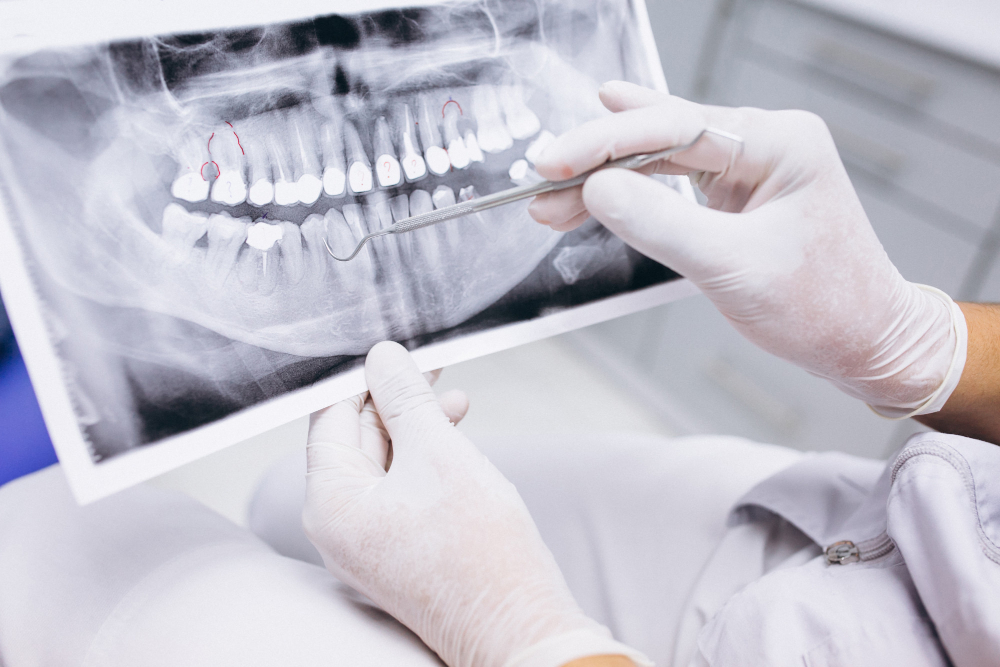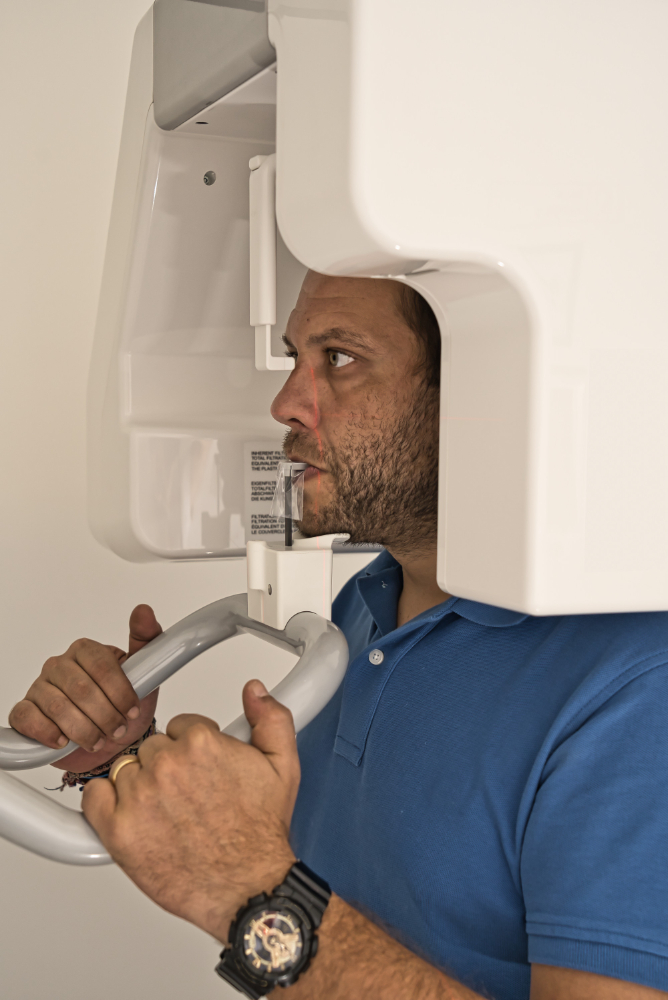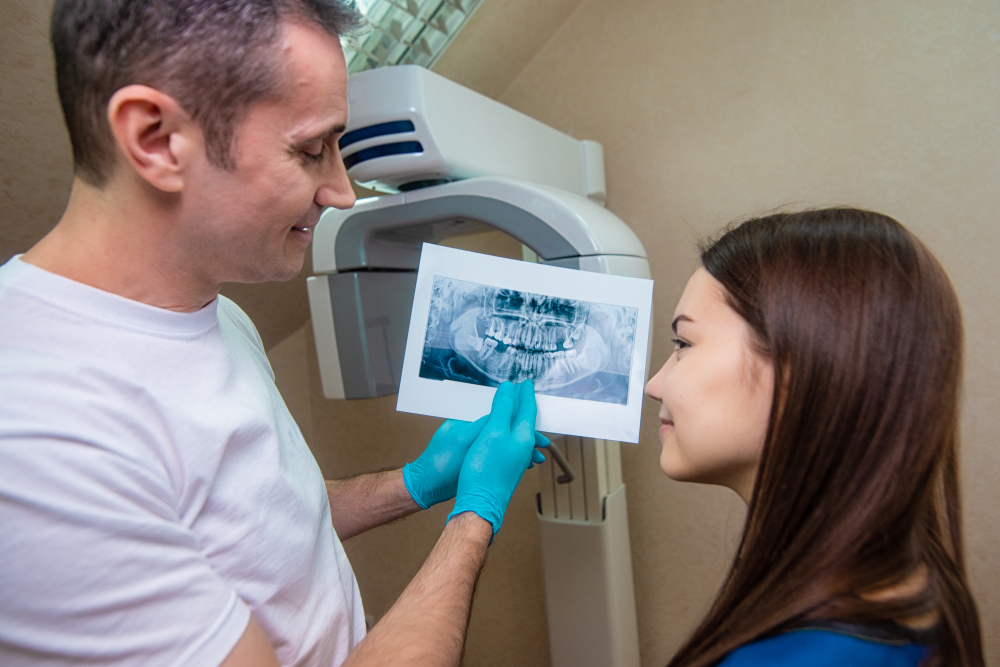
What is a panoramic dental X-ray?
You may be familiar with a routine dental x-ray where a dentist puts a plastic-wrapped film in your mouth or a sensor to click an image of your teeth. These are known as intraoral periapical x-rays and show a couple of teeth and the jaw bone surrounding them. X-rays help your dentist to analyse and determine the extent of oral diseases and plan the treatment accordingly.
Similarly, a panoramic dental x-ray creates an image of the entire mouth. A panoramic X-ray helps visualise the mouth as the whole, which includes the upper and lower jaw and all the teeth, the temporomandibular joint (jaw joint) and even the nasal areas and sinuses.
What does a panoramic X-ray show and diagnose?

- Chipped teeth can result from biting down on a hard substance, like hard candies, nuts, bones or ice.
- Trauma to teeth because of a fall or a blow to the (due to a road traffic accident, for example).
- Playing contact sports without a mouth guard or getting hit on the face by a football.
- Bruxism (clenching of teeth during sleep) generates enormous pressure on your teeth. Chronic jaw clenching weakens teeth and can lead to a fracture of the tooth.
- Teeth can also chip when they are weakened due to wear and tear. Dental cavities can weaken the tooth structure making it more likely to chip off. Large dental cavities disrupt the tooth structure’s integrity, making them susceptible to breakage even on minimal trauma or chewing.
- Conditions like acid reflux bring stomach acid to your mouth, which damages the tooth enamel. Once the tooth enamel is damaged, the tooth becomes weak and loses its integrity, making it prone to chipping and breakage.
- The consumption of acidic foods and liquids.
- Large fillings also weaken teeth, putting them at risk of breakage and chipping.
- Age, as with advanced age, teeth’s structure alters and often cracks.
How does a panoramic dental X-ray work?

Unlike traditional dental x-rays taken intraorally, meaning the sensor or the radiographical film is placed inside the mouth, panoramic x-rays are extraoral. This means that the imaging sensors and the machine is outside the mouth.
During the panoramic x-rays, you will have to stand between the panoramic dental machine as directed by our dental professional. Your head will be stabilised, and you will be asked to bite on a bite block to perfectly align your teeth. You will also be asked to wear a lead apron to protect your body from receiving unnecessary x-rays. Apart from this, you will be instructed to remove any jewellery you are wearing as it may obstruct the x-rays and lead to a faulty image.
Next, the machine will be turned on, which has an x-ray tube attached to it. The x-ray tube will rotate in a semicircle around your head, starting from one side of the jaw to the other. The x-ray tube will continuously project x-ray beams through your mouth to the film rotating opposite to the x-ray tube. The entire procedure lasts 15-30 seconds, it is done quickly, and it is quite comfortable. Make sure you are standing still during the process, as the movement of the head will lead to hazy and faulty imaging.
When is a panoramic X-ray needed?

Unlike traditional dental x-rays taken intraorally, meaning the sensor or the radiographical film is placed inside the mouth, panoramic x-rays are extraoral. This means that the imaging sensors and the machine is outside the mouth.
During the panoramic x-rays, you will have to stand between the panoramic dental machine as directed by our dental professional. Your head will be stabilised, and you will be asked to bite on a bite block to perfectly align your teeth. You will also be asked to wear a lead apron to protect your body from receiving unnecessary x-rays. Apart from this, you will be instructed to remove any jewellery you are wearing as it may obstruct the x-rays and lead to a faulty image.
Next, the machine will be turned on, which has an x-ray tube attached to it. The x-ray tube will rotate in a semicircle around your head, starting from one side of the jaw to the other. The x-ray tube will continuously project x-ray beams through your mouth to the film rotating opposite to the x-ray tube. The entire procedure lasts 15-30 seconds, it is done quickly, and it is quite comfortable. Make sure you are standing still during the process, as the movement of the head will lead to hazy and faulty imaging.
Advantages of panoramic X-rays

Panoramic radiography offers a plethora of advantages over traditional intraoral radiography like –
- One x-ray is enough to the study upper and lower jaw—no need for several x-rays.
- Since the film is placed outside the mouth, it is more comfortable for you as a patient.
- The process is quick and straightforward.
- The amount of radiation you receive is low.
- It allows us to diagnose multiple dental problems in a single x-ray, be it cavities, impacted teeth or even cancer.
Disadvantages of panoramic x-rays

Panoramic radiography offers a plethora of advantages over traditional intraoral radiography like –
- One x-ray is enough to the study upper and lower jaw—no need for several x-rays.
- Since the film is placed outside the mouth, it is more comfortable for you as a patient.
- The process is quick and straightforward.
- The amount of radiation you receive is low.
- It allows us to diagnose multiple dental problems in a single x-ray, be it cavities, impacted teeth or even cancer.
